Bak Kay
Bak Kay are the shavings of a dried root that
are a very common ingredient of home made soups
and Chinese medicines. They can also be found
sparingly scattered in many hot pot dishes from
all over China. The thin strips as about a quarter
of an inch wide by several inches in length. |
| |
|
Bak Kay are used when the weather is very hot,
and are considered very good for cooling the blood
naturally.
Bak Kay would normally need an hour or so to soften,
being added dried to the soup. They are delicious
in a rather tasteless sort of way, and I enjoy
eating a few of them with my soup.
Bak Kay is one of the few words that is not given
in Yueping, but is of local origin. My wife has
no idea what other names my be used for them,
but we guess they will be quite similar to this
in Toisanwah (Taishanese or Taishanhua). |
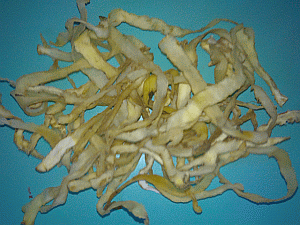 |
| |
|
Dong Gui
Although similar in looks to Bak Kay above, Dong
Gui have different properties. The name should
probably mean "Eastern Ghost". These
are a thinly sliced root about 1 inch wide by
a couple of inches long. |
| |
|
Dong Gui are especially useful for 'Girl Blood'
as my wife so eloquently described their use.
Upon questioning she confirmed my presumption
that they help greatly at certain periods of the
month. Working to harmonize the body's blood,
Dong Gui can also have helpful properties for
menopausal women.
They are generally used in everyday soups, added
dry and simmered for an hour or more, and until
soft. They can also be beneficial for boys, and
are definitely on my 'edible' list. |
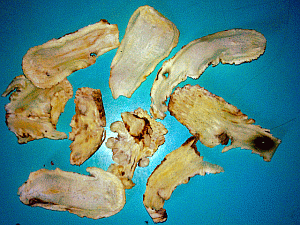 |
| |
|
Dong San
Dong San are roots about 1/4 inch wide by several
inches long. They are one of the most common ingredients
in Chinese soups. |
| |
|
Along with Gay d'Zhee these roots are probably
one of the commonest medicianal ingredients in
everyday Chinese cooking. They are added to promote
healthy blood.
They are generally used in everyday soups, stews
and hot pot dishes, and should be considered as
one of the basic ingredients for all such dishes. |
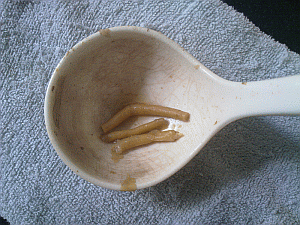 |
| |
|
Gay d'Zhee
These are small oval orange fruits about 1/4 inch
long. They are one of the most common ingredients
in Chinese soups. |
| |
|
Very often used in combination with Dong
San above, these two medicinal ingredients are
added to most Chinese soups, stews and hot pots.
Gay d'Zhee are very good for the blood system
and can be used in tandem with other ingredients
listed on this page.
When cooked they can double in size and may start
to break down if roughly stirred or cooked for
more than 4 hours. However, a long cooking does
release more of their medical properties. |
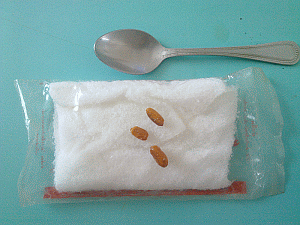 |
| |
|
Ham Dan or Salty Eggs
Ham Dan or 'Salty Eggs' are one of the more curious
Chinese dishes that have a specific purpose. They
are used to counter the feelings of light-headedness
some people occasionally suffer from. Perhaps
you stand up and suddenly feel as if you may pass-out?
I think most of us have experienced this nauseous
feeling from time to time. |
| |
|
According to my wife, Salty Eggs are the immediate
cure.
First of all, these are not any old Chicken's
eggs. These have to be the almost white ones,
and should be organic / naturally grown and harvested.
The cooking is very simple, and quite like boiled
eggs, except:
1. You
need to fill a pot with a very course kosher or
rock salt. The salt grains should be as large
as possible and easy to pick up an individual
grain in your fingers.
2.
The salt is added to a large sealed crock and
the eggs embedded in the salt. Then more salt
is added to completely cover the eggs. My wife
used about 2 Lbs of this salt.
3.
The crock has a double lid, and is placed
in a large jam kettle or similar, resting on a
towel to cushion the heat from the gas ring. Water
is added to the kettle, brought to the boil, and
then left to simmer for at least 3-hours with
the lid on.
4. Check every
so often there is still water for steaming, and
add more as required. Remember to replace the
lid of the jam kettle once done.
5.
The pictures (Right) were taken after
steaming for 4-hours, and you will notice the
salt crystals are still intact. They are later
stored for future use with this dish.
6.
The eggs when finished cooking can be
eaten either hot or cold, but hot is preferred.
Shell them just as you would a normal hard boiled
egg, and enjoy!
|
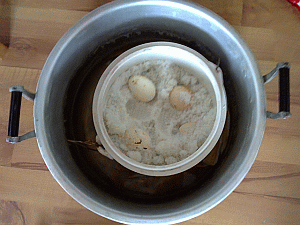
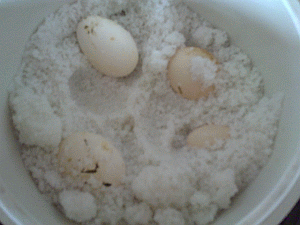
 
|
| |
|
| From the dozen eggs that she cooked,
my wife immediately ate 8 of them - and that's
a lot of eggs! However, her condition vanished,
so all I can say is "Don't knock it till
you try it!" |
| |
|
Red Dates or Hong Zhao
Hong Zhao is the name for Chinese red dates, which
are usually found dried. They are also available
as 'Chinese sweets' and I use the term quite broadly.
They are one of the most common ingredients of
any standard Chinese soup, and are very similar
in look, taste, and usage to British Rose Hips.They
can also be added to hot pot, and have culinary
and medicinal uses in many other dishes.
Treat them as you would rose hips, and add for
their general tonic properties and taste. They
should be naturally sweet, but this is a compound
flavour which is quite subtle and unique. |
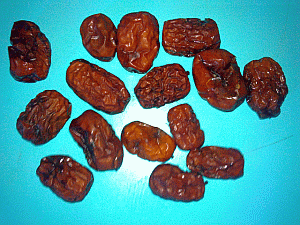 |
| |
|
| Whilst cooked Hong Zhao are very
soft to eat, with even the skin becoming very
edible, please know Chinese will always cook and
serve them so as to include the single central
stone. |
| |
|
| Lin Zhi and Yue Mei |
| |
|
Lin Zhi, properly pronounced 'lien' are a type
of nut, whilst the smaller type of pea shown is
called Yue Mei.
These two ingredients are usually used together,
and especially for making the specific Cantonese
dish, which is basically any Chinese soup made
with Chicken's Feet.
Chinese Chicken's Feet Soup would perhaps not
rate as one of my all-time personal favourites,
but Chinese girls love it! Whilst I may personally
remain underwhelmed, this soup when made properly
is very beneficial for those suffering from foot
conditions (And Chinese wives). |
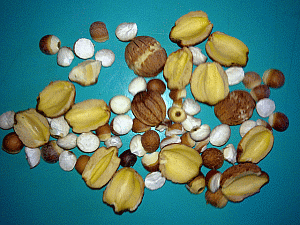 |
| |
|
Mango or Mok Gwa
This common fruit helps promote milk production
for breastfeeding mothers. My wife used Mango
in soup to help her produce milk.
Mango also promotes healthy skin, but this is
more beneficial if the mango's are eaten fresh,
not cooked.
Related Page: Mango
Gives more details of this common fruit and several
unusual recipes, including a delicious soup. |
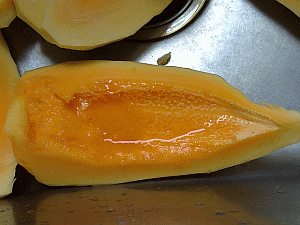 |
| |
|
| Red Beans |
| |
|
Chinese Red Beans are a very common addition
to soups and stews and are considered to be a
tonic.
I would wash them before adding to the pot, although
Chinese seldom bother.
These beans should be cooked for about one hour,
which is ideal when making soups. They will swell
to double their size during cooking and also turn
brown.
I find them a little earthy and boring, but a
few are fine to eat. |
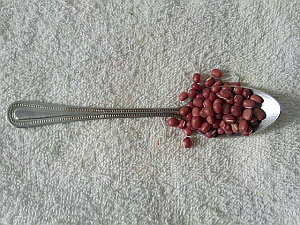 |
| |
|
| Sam Xi |
| |
|
Sam Xi is yet another root with medicinal properties.
They are bought in bunches as shown right, and
should be washed before use.
Sam Xi feel a little like angelica to the touch,
with a few roots being added occasionally to soups
and medicinal concoctions. However these would
normally be used to make a Chinese tonic tea,
which is known as 'leung cha' or 'two tea' in
English
Like most of the ingredients on this page, these
roots may be stored for many months and my wife
keeps ours in the fridge. |
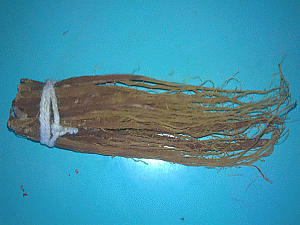 |
| |
|
| Vine Leaves |
| |
|
Ground vine leaves may not be related to
the vine genus at all, but are an excellent tonic
and assist recuperation from many minor ailments.
They can also be served stir-fryed as a vegetable.
To make a medicinal Tea, simply remove the leaves
from the stem and wash well. Place in a rice cooker
set to 'porridge', or simmer in a pan with several
pints of water for a couple of hours.
Once you see the indicative yellow tea forming,
strain badly so some of the leaves enter the serving
dish, and give to your loved one.
My Cantonese wife has cooked these several times
for me - when I have been labouring for breath,
or had a bad foot. They work! |
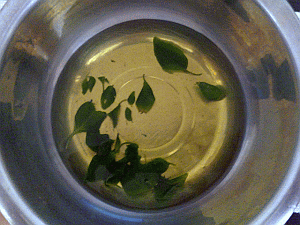 |
| |
|
| White Roots |
| |
|
These are yet another root with medicinal properties
and are often found in soups and stews. They are
bought as shown right, and should be washed before
use.
Chop into lengths of between 1 and 4 inches, as
best suits the dish being made.
They are cooked when they are soft. They are considered
to be a general tonic and work well with soups
and stews. |
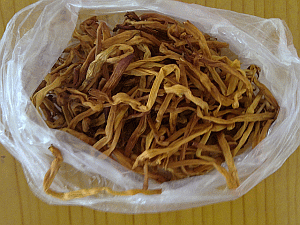 |
| |
|
Yuk Choi
These are long roots about 1/4 inch wide by at
least 6 inches long and are used in medicinal
soups. They are very good for 'girls' and used
for relieving mentral problems and balancing the
blood. |
| |
|
Do note eat these!
Cooking releases medicines into the soup, and
whilst eating them may not cause any problems,
my wife told me not to.
Prepare for use by washing lightly under running
water and then chop diagonally into inch long
slices. Cover with water and leave to soak for
several hours. The ones pictured were soaked for
4 hours, and lost their initial whiter insides.
Soup Recipe
* 1 handful Yuk Choi
* 1 or 2 pork knuckles
(Usually vertibrae)
1/2 cup red beans
* A few Dong Gui or 'white roots'
* 1 dozen or more Red Dates
Put in a wok with water from the yuk choi and
simmer for an hour or more. Add more water as
required to make a thin soup.You can add other
ingredients as you please.
When ready drink a bowl of the liquid and enjoy
the meal. I find this needs added salt and pepper,
but otherwise it tastes good.
|
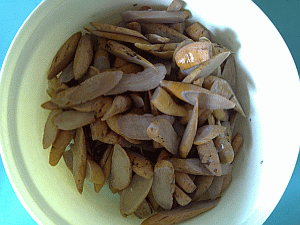
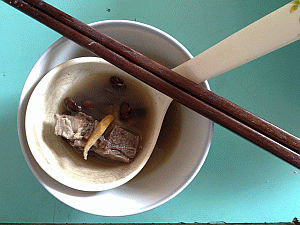
|
| |
|
Yun Sam
These things are a little over an inch long by
a quarter inch wide. They resemble dried branches,
although I am informed they are in fact a type
of root. |
| |
|
Prepare for use by washing lightly under running
water and then chop with a hefty knife into slivers
across their width. You will end up with something
that resembles small coins. One or two pieces
should be sufficient for most soups, although
as a medicinal ingredient this may be increased
somewhat.
They are a fairly common ingredient of Cantonese
soups, and have the effect of reducing internal
body heat - which can be a real problem in this
hot and humid part of China. As usual they are
left to simmer in the soup for an hour or longer. |
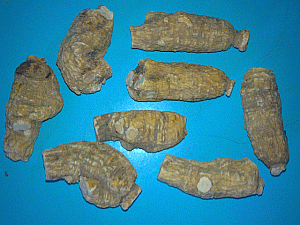 |